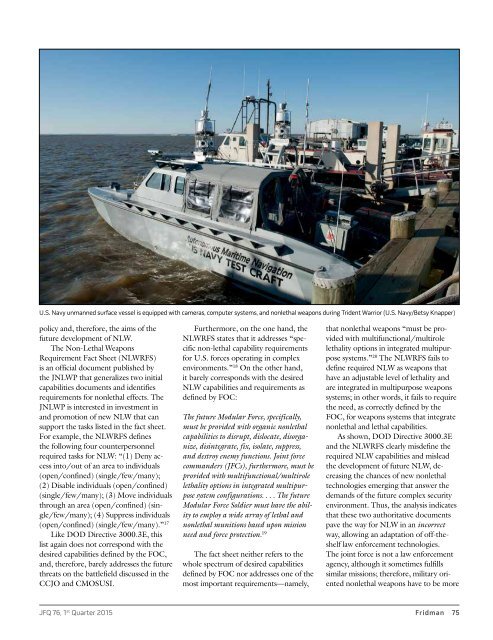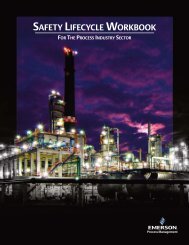jfq-76
jfq-76
jfq-76
Create successful ePaper yourself
Turn your PDF publications into a flip-book with our unique Google optimized e-Paper software.
U.S. Navy unmanned surface vessel is equipped with cameras, computer systems, and nonlethal weapons during Trident Warrior (U.S. Navy/Betsy Knapper)<br />
policy and, therefore, the aims of the<br />
future development of NLW.<br />
The Non-Lethal Weapons<br />
Requirement Fact Sheet (NLWRFS)<br />
is an official document published by<br />
the JNLWP that generalizes two initial<br />
capabilities documents and identifies<br />
requirements for nonlethal effects. The<br />
JNLWP is interested in investment in<br />
and promotion of new NLW that can<br />
support the tasks listed in the fact sheet.<br />
For example, the NLWRFS defines<br />
the following four counterpersonnel<br />
required tasks for NLW: “(1) Deny access<br />
into/out of an area to individuals<br />
(open/confined) (single/few/many);<br />
(2) Disable individuals (open/confined)<br />
(single/few/many); (3) Move individuals<br />
through an area (open/confined) (single/few/many);<br />
(4) Suppress individuals<br />
(open/confined) (single/few/many).” 17<br />
Like DOD Directive 3000.3E, this<br />
list again does not correspond with the<br />
desired capabilities defined by the FOC,<br />
and, therefore, barely addresses the future<br />
threats on the battlefield discussed in the<br />
CCJO and CMOSUSI.<br />
Furthermore, on the one hand, the<br />
NLWRFS states that it addresses “specific<br />
non-lethal capability requirements<br />
for U.S. forces operating in complex<br />
environments.” 18 On the other hand,<br />
it barely corresponds with the desired<br />
NLW capabilities and requirements as<br />
defined by FOC:<br />
The future Modular Force, specifically,<br />
must be provided with organic nonlethal<br />
capabilities to disrupt, dislocate, disorganize,<br />
disintegrate, fix, isolate, suppress,<br />
and destroy enemy functions. Joint force<br />
commanders (JFCs), furthermore, must be<br />
provided with multifunctional/multirole<br />
lethality options in integrated multipurpose<br />
system configurations. . . . The future<br />
Modular Force Soldier must have the ability<br />
to employ a wide array of lethal and<br />
nonlethal munitions based upon mission<br />
need and force protection. 19<br />
The fact sheet neither refers to the<br />
whole spectrum of desired capabilities<br />
defined by FOC nor addresses one of the<br />
most important requirements—namely,<br />
that nonlethal weapons “must be provided<br />
with multifunctional/multirole<br />
lethality options in integrated multipurpose<br />
systems.” 20 The NLWRFS fails to<br />
define required NLW as weapons that<br />
have an adjustable level of lethality and<br />
are integrated in multipurpose weapons<br />
systems; in other words, it fails to require<br />
the need, as correctly defined by the<br />
FOC, for weapons systems that integrate<br />
nonlethal and lethal capabilities.<br />
As shown, DOD Directive 3000.3E<br />
and the NLWRFS clearly misdefine the<br />
required NLW capabilities and mislead<br />
the development of future NLW, decreasing<br />
the chances of new nonlethal<br />
technologies emerging that answer the<br />
demands of the future complex security<br />
environment. Thus, the analysis indicates<br />
that these two authoritative documents<br />
pave the way for NLW in an incorrect<br />
way, allowing an adaptation of off-theshelf<br />
law enforcement technologies.<br />
The joint force is not a law enforcement<br />
agency, although it sometimes fulfills<br />
similar missions; therefore, military oriented<br />
nonlethal weapons have to be more<br />
JFQ <strong>76</strong>, 1 st Quarter 2015 Fridman 75




